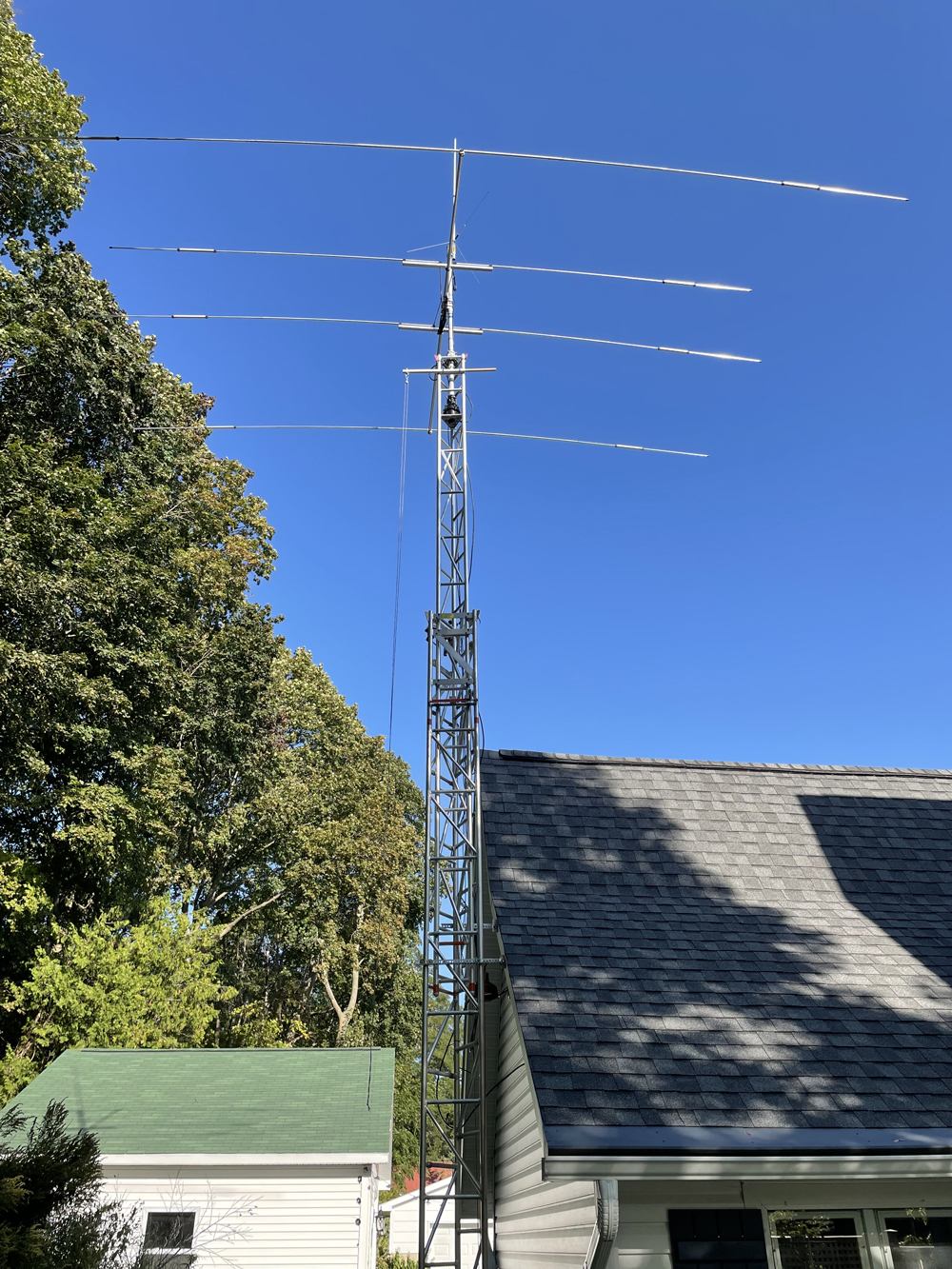Home CB Radio Antenna: Boost Your Signal Today

CB radios are popular for communication. Having a good antenna is key.
Whether you’re new to CB radios or an enthusiast, understanding antennas is important. They help in receiving and transmitting signals effectively. A reliable home CB radio antenna can enhance your communication experience, ensuring clear and uninterrupted transmissions. This introduction will explore why having the right antenna matters.
It will provide insights into what makes an antenna effective for home use. You’ll learn about factors like placement, design, and signal strength. These elements affect performance and reliability. Discover how to choose the best CB radio antenna for your needs. Enhance your setup and enjoy better communication with friends and fellow hobbyists. Let’s dive into the world of CB radio antennas!

Credit: www.reddit.com
Choosing The Right Cb Radio Antenna
Choosing the right CB radio antenna is crucial for optimal performance. The antenna affects signal strength, range, and clarity. A good choice ensures clear communication. It also reduces interference and static.
Factors To Consider
Several factors impact your antenna choice. First, consider the length. Longer antennas often have better range. But they may be less convenient. Think about where you’ll place the antenna. Some locations may limit options. Material is another consideration. Stainless steel is durable. Fiberglass can be lighter. Consider your budget. Prices vary widely. Look for the best value.
Popular Types
There are various CB radio antenna types. The whip antenna is common. It’s long and flexible. Another type is the magnetic mount antenna. It’s easy to install and remove. The fiberglass antenna is lightweight. It often works well in windy conditions. Consider the center-loaded antenna. It’s designed for better reception. Each type has unique benefits. Choose based on your needs.
Installation Basics
Installing a home CB radio antenna can boost your communication range. Proper setup ensures clear signals and effective communication. Whether you’re a hobbyist or need it for emergencies, it’s essential to get the installation right. Let’s dive into the essentials you need to know.
Tools Needed
- Screwdriver
- Wrench set
- Coaxial cable
- Drill
- Measuring tape
- Grounding wire
Having the right tools makes the process smoother. Gather these tools before starting the installation.
Step-by-step Guide
- Choose the Location: Pick a high spot for the antenna. Roofs or tall poles work best.
- Mount the Antenna: Secure the antenna to the chosen spot using brackets. Make sure it is stable.
- Run the Coaxial Cable: Connect the antenna to your CB radio with the cable. Ensure no kinks in the cable.
- Ground the Antenna: Use grounding wire to protect from lightning. Attach it securely to the ground.
- Test the Setup: Turn on your CB radio. Check for clear reception and transmission.
Carefully follow each step for optimal performance. With this guide, your CB radio antenna will be set up efficiently.
Enhancing Signal Strength
Boost signal strength with a home CB radio antenna. Install it in a high location for better reception. Ensure proper alignment to minimize interference and maximize clarity.
Enhancing signal strength is crucial for getting the most out of your home CB radio antenna. Strong signals mean clearer communication and fewer dropped conversations. Whether you’re a hobbyist or rely on CB radio for emergencies, optimizing signal strength is a game-changer. Let’s dive into practical ways to boost your signal, starting with where to place your antenna.Optimal Placement Tips
Location is everything when it comes to your antenna. Placing it high, such as on the roof or a tall mast, can drastically improve signal reception. Think about obstacles like trees or buildings. Avoid them as they can block your signal. Consider the orientation; aligning the antenna vertically often enhances signal reach.Reducing Interference
Interference can ruin the clarity of your communication. It’s like static noise that hinders your signal. Start by keeping electronic devices away from your antenna. Devices like microwaves and cordless phones can interfere with your CB radio signal. What about wiring? Ensure all connections are secure and minimize cable length to reduce interference. Sometimes, a simple change can make a big difference. Have you ever tried adjusting your antenna’s angle slightly? It can help reduce nearby interference. Enhancing your CB radio signal is about thoughtful placement and reducing interference. How will you adjust your setup for better communication?Maintenance Tips
Keep your CB radio antenna clean by gently wiping it with a damp cloth. Regularly check for rust or damage to ensure optimal performance. Adjust the antenna’s angle for better signal reception.
Maintaining your home CB radio antenna is crucial for ensuring clear and consistent communication. A well-maintained antenna not only enhances performance but also extends the lifespan of your equipment. With regular attention and a few simple steps, you can keep your antenna in top shape. Dive into these maintenance tips to make sure your CB radio system serves you well for years to come.Regular Checks
Regular checks are the cornerstone of a healthy antenna system. Inspect your antenna for physical damage, such as cracks or rust. This can prevent signal loss and costly replacements. Tighten all connections to ensure optimal performance. Loose connections can lead to poor transmission quality. It’s amazing how a simple twist can improve clarity. Check the SWR (Standing Wave Ratio) readings monthly. High SWR readings can indicate issues with your antenna setup. A quick check can save hours of troubleshooting later.Troubleshooting Common Issues
Encountering issues with your CB radio antenna can be frustrating. Often, the solution is simpler than you might think. Start by verifying if all cables are correctly connected. If you experience static or weak signals, consider environmental factors. Nearby tall buildings or trees might be interfering with your signal. Relocating your antenna might solve the problem. Check for corrosion on connectors. Corroded connectors can severely impact your signal quality. A little cleaning or replacing these parts can restore functionality. Have you ever felt the sheer joy of solving a problem yourself? Regular maintenance and troubleshooting can lead to those satisfying moments. Keep your antenna in check, and you’ll enjoy clearer communications. How often do you perform maintenance on your equipment? It’s worth considering more frequent checks to avoid unexpected issues.Understanding Antenna Tuners
Antenna tuners play a vital role in optimizing home CB radio antennas. They adjust the antenna system’s impedance, ensuring better signal transmission and reception. This tuning helps achieve clearer communication by matching the antenna to the radio’s frequency.
When setting up a home CB radio system, understanding antenna tuners can make a world of difference in optimizing performance. Antenna tuners are essential tools that ensure your CB radio operates at its best by matching the impedance of your antenna system to your radio. This process maximizes the power transferred from your radio to the antenna, ensuring clearer communication. Have you ever experienced poor signal quality? This could be due to an impedance mismatch that an antenna tuner could easily fix.Benefits Of Tuning
Tuning your antenna with a tuner can significantly enhance your CB radio’s performance. A well-tuned antenna reduces signal loss, improving both the clarity and range of your transmissions. Imagine having a conversation with someone miles away without interference or static. That’s the power of a perfectly tuned antenna. Additionally, tuning can protect your radio from damage by ensuring that all power is efficiently transmitted, reducing the risk of overheating.How To Use A Tuner
Using an antenna tuner is straightforward, even for beginners. Start by connecting the tuner between your radio and antenna. Most tuners come with simple instructions that guide you through the setup process. Once connected, you’ll adjust the knobs or settings on the tuner while monitoring the SWR (Standing Wave Ratio) meter. The goal is to achieve the lowest possible SWR reading, ideally below 1.5, which indicates optimal tuning. Have you ever felt the frustration of poor signal during an important communication? Taking a few minutes to adjust your tuner can transform your CB radio experience. It’s a small step that ensures you’re always heard loud and clear. By embracing these practical steps, you ensure that your CB radio system is always ready to perform at its best. Ready to start tuning?Diy Antenna Projects
Building your own CB radio antenna at home can be fun. It’s a great way to understand radio waves. Plus, it can save you money. This project requires some basic tools. Anyone can try it with a little patience.
Let’s dive into the steps. We’ll guide you through materials and building. No need for complex jargon here. Just simple, clear instructions to get you started.
Materials You’ll Need
First, gather your materials. You’ll need copper wire, about 18-gauge. A PVC pipe, around 10 feet long, works well for the mast. Get some connectors, like UHF connectors. Insulating tape will be helpful too. You might need a soldering iron. A few basic tools like pliers and a screwdriver complete the list.
Building Your Own Antenna
Start by measuring your copper wire. Cut it to around 8.5 feet. This length is ideal for CB radios. Wrap the wire around the PVC pipe. Make sure it’s tight and even. Use the insulating tape to secure it in place.
Next, attach the connectors. Solder them to the ends of the wire. Ensure they’re secure. This helps transmit signals clearly. Fix the PVC pipe upright. You can attach it to a pole or wall.
Test your new antenna. Connect it to your CB radio. Adjust the positioning for the best signal. Enjoy clear communication with your custom-made antenna.
Safety Precautions
Ensure the CB radio antenna is securely mounted to prevent accidents. Avoid proximity to power lines for safety. Regularly check connections to keep them intact and free from weather damage.
Setting up a CB radio antenna at home offers a unique communication experience. However, it’s crucial to consider safety precautions during installation. Neglecting these can lead to accidents or damage. How can you ensure your setup is safe for everyone involved?Electrical Safety
Handling electricity can be dangerous, especially if you’re not familiar with it. Always ensure that the power is off before starting any installation work. Using insulated tools can prevent accidental shocks. Are you aware of the risks involved with electrical work? Even small mistakes can cause fires or other hazards. Consider using a voltage tester to check live wires before touching them.Proper Grounding
Grounding is essential to protect your equipment and yourself from electrical surges. Without proper grounding, your CB radio could malfunction or cause injury. How do you ensure your antenna is grounded correctly? Install a grounding rod and connect it to your antenna setup. This simple step can save you from potential electrical disasters. Ensuring your CB radio antenna is safe involves careful planning and execution. These precautions not only protect your investment but also keep your home environment safe. Are you ready to make safety a priority in your antenna setup?
Credit: www.rightchannelradios.com
Maximizing Performance
Enhancing your home CB radio antenna can improve your communication range. By focusing on performance, you can achieve clearer signals. Simple upgrades and techniques can make a big difference.
Advanced Techniques
Positioning your antenna is crucial. Place it as high as possible. This reduces obstacles that block signals. Keep the antenna away from large metal objects. They can interfere with transmission.
Use a signal analyzer to check performance. Adjust the antenna based on feedback. This ensures optimal signal strength. Regular maintenance also helps. Clean connections and check for wear.
Upgrading Components
Consider upgrading the coaxial cable. Higher quality cables transmit signals better. Look for cables with low loss ratings. This helps keep signals strong and clear.
Replace old connectors with new ones. Corroded connectors can weaken signals. Quality connectors ensure good signal transfer. Invest in a robust antenna mast. This provides stability and durability.
Choose an antenna with a high gain rating. Higher gain antennas offer better reception. They capture signals more effectively. This can greatly improve communication quality.

Credit: www.ebay.com
Frequently Asked Questions
What Is The Best Home Base Cb Antenna?
The Solarcon A-99 is often considered the best home base CB antenna. It offers excellent range, easy installation, and durability. Its fiberglass design ensures weather resistance, making it a top choice for reliable communication. Users praise its performance for both local and long-distance transmissions.
Can You Make A Homemade Cb Antenna?
Yes, you can make a homemade CB antenna using materials like copper wire and PVC pipe. Ensure proper tuning for optimal performance. Building one can enhance your CB radio experience and is cost-effective. Remember to follow safety guidelines and legal regulations when constructing and using the antenna.
What Is The Best Antenna For A Cb Radio?
The best CB radio antenna is the Wilson 5000. It offers excellent performance, durability, and range. It’s ideal for professional drivers needing reliable communication. Its design ensures maximum signal strength and clarity, enhancing your CB radio experience. Always consider your vehicle type and usage for optimal results.
Will A Cb Antenna Work Inside A House?
A CB antenna can work inside a house, but it may experience reduced performance. Indoor placement can cause signal interference and limit range. For optimal performance, place the antenna near a window or higher location. Outdoor installation is recommended for the best signal reception and transmission.
Conclusion
Choosing the right CB radio antenna enhances your communication experience. It boosts signal quality, ensuring clear conversations. Consider your space and environment when selecting an antenna. Mounting height plays a crucial role in performance. Regular maintenance keeps your antenna in top shape.
Proper tuning optimizes signal reach. Explore different models for varied features. A well-chosen antenna makes your CB radio efficient. Enjoy reliable communication with the right setup. Stay connected effortlessly, sharing your voice across distances. Prioritize quality and compatibility for the best results.
Your CB radio antenna choice matters. Keep talking, keep listening, keep connected.
